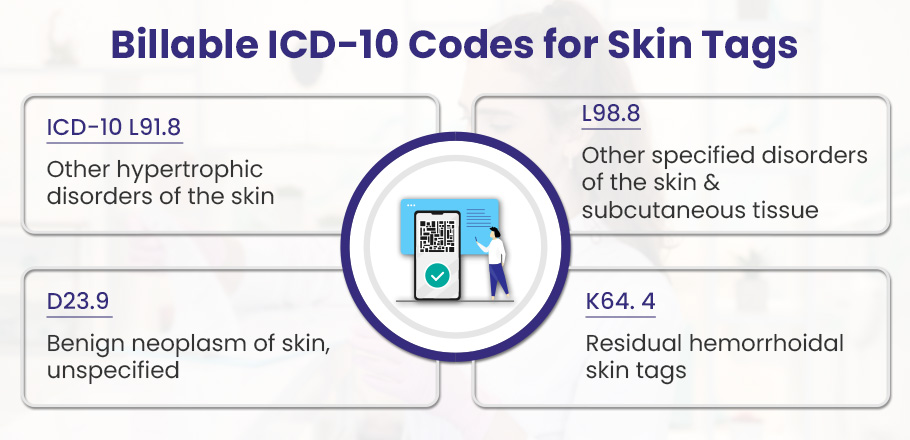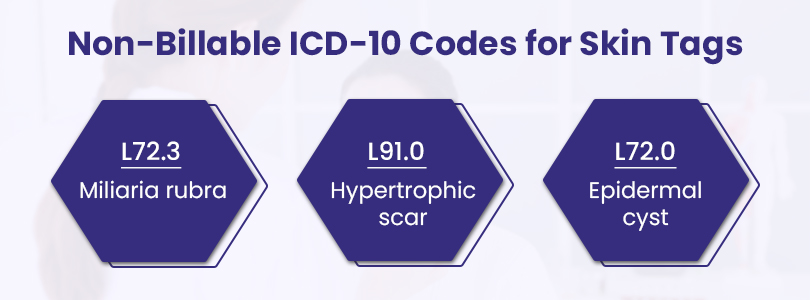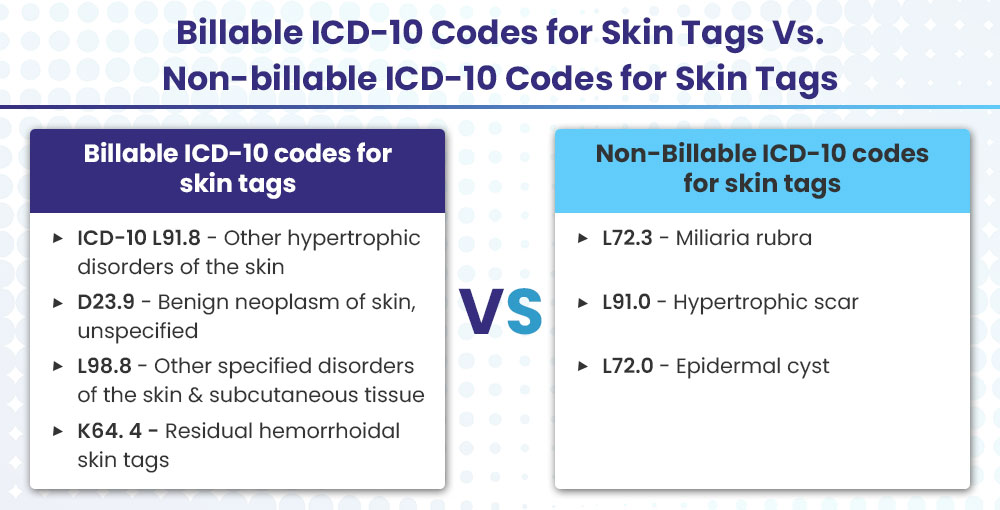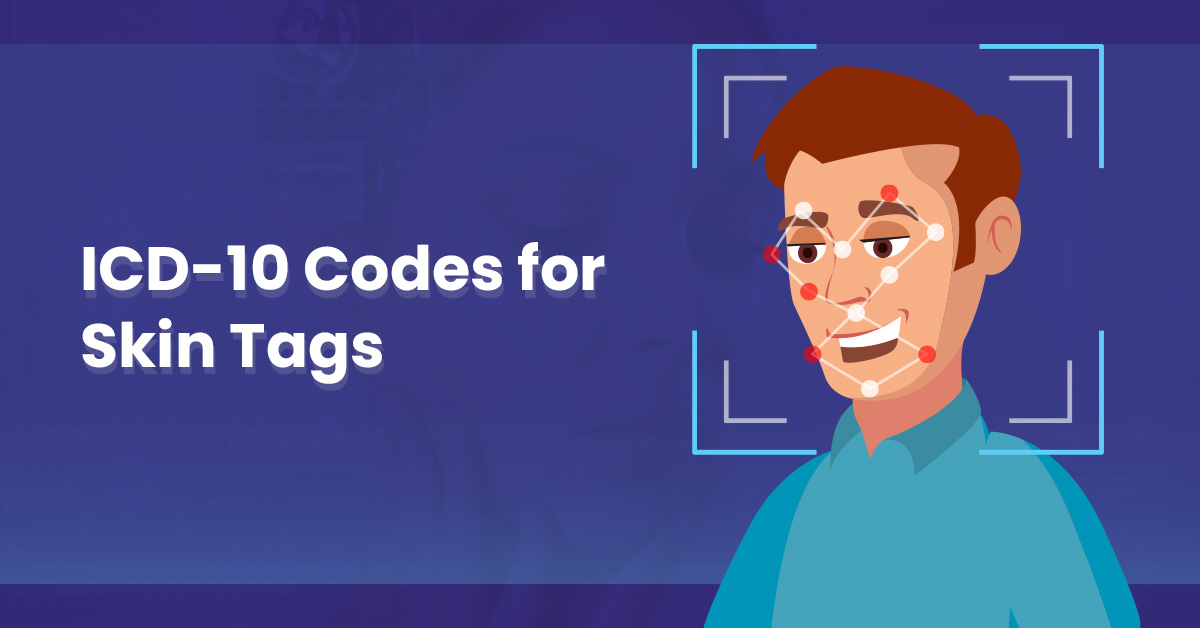Skin tags are tiny, soft, and harmless lumps that hang from the skin. They are generally harmless but can become irritated or bleed if constantly rubbed against clothing or jewelry. While many people choose to remove skin tags for cosmetic reasons, sometimes their removal is medically necessary, especially if they get frequently irritated or bleed.
It is very important for healthcare providers to use the right ICD-10 codes when removing skin tags. Wrong coding can cause insurance companies to deny claims or delay payments. Insurers usually do not pay for skin tag removal if it is only for physical appearance. The procedure must be medically required.
Finding the correct ICD-10 code for skin tags can be tricky. This is because other skin problems can look like skin tags but are not the same. So, these conditions should not use ICD-10-CM L91.8 or any other code for skin tags.
The ICD-10-CM L91.8 code is generally used for other hypertrophic skin diseases in the absence of a specific skin tag diagnosis. Healthcare providers need to know the ICD-10 codes for skin conditions and diseases. This helps them code correctly and get paid on time.
Skin Tag ICD-10 Codes List
| Skin Tag Location/Condition | ICD-10 Code | Reason/Explanation | Billable/Unbillable |
| Neck | L91.8 | Hypertrophic skin disorders can include skin tags in areas like the neck. | Billable |
| Irritated | L91.8 | Irritated skin tags fall under “Other hypertrophic disorders of the skin.” | Billable |
| Inflamed | L98.8 | Inflamed skin tags can be coded under “Other specified disorders of skin.” | Billable |
| Eyelid | D23.9 | Benign neoplasm of skin; covers skin tags in specific locations like the eyelid. | Billable |
| Face | D23.9 | Benign neoplasm of skin, unspecified, applies to facial skin tags. | Billable |
| Left Axilla | L91.8 | Hypertrophic skin disorders, such as skin tags, may occur in the axilla. | Billable |
| Bleeding | L98.8 | Bleeding skin tags are considered “Other specified disorders of the skin.” | Billable |
| Rectal | K64.4 | Residual hemorrhoidal skin tags are often found in the rectal region. | Billable |
| Genital | L98.8 | Genital skin tags fall under “Other specified disorders of the skin.” | Billable |
| Unspecified | D23.9 | Unclassified benign neoplasm of skin, including unspecified skin tags. | Billable |
| Labial | L98.8 | Skin tags on the labia are classified as “Other specified disorders of the skin.” | Billable |
| Groin | L91.8 | Hypertrophic disorders include skin tags in the groin area. | Billable |
| Back | D23.9 | Benign neoplasm of skin; back is included under unspecified locations. | Billable |
| Perianal | K64.4 | Perianal skin tags are classified under residual hemorrhoidal skin tags. | Billable |
| Ear | D23.9 | Benign neoplasm of skin, unspecified, includes locations like the ear. | Billable |
| Anus | K64.4 | Residual hemorrhoidal skin tags commonly occur around the anus. | Billable |
This article gives a simple overview of common ICD-10 codes for skin tags. It includes easy clinical information and states if each code can be billed or not. This will help healthcare providers pick the right code for their patients’ conditions and improve the chances of getting paid back.

Billable ICD-10 Codes for Skin Tags
There are several ICD-10 codes that can be used to bill for the removal of skin tags that are causing symptoms or for medical reasons. These valid ICD-10 codes include L91.8 for other specified hypertrophic disorders of the skin and L98.8 for other specified disorders of the skin and subcutaneous tissue. Using one of these codes along with the appropriate CPT code allows providers to be reimbursed for medically necessary skin tag removal procedures.
Here are the billable ICD-10 codes for skin tags:
ICD-10 L91.8 — Other hypertrophic disorders of the skin
The ICD-10 code L91.8 means “Other hypertrophic disorders of the skin.” This code is used to record skin tag diagnoses when there is no specific code available. This code includes different skin problems that are overgrown, like skin tags.
It’s important to note that ICD-10 L91.8 is a general code. Therefore, healthcare providers should try to use more specific codes when they can. However, in cases where a more precise diagnosis cannot be made, L91.8 serves as a catch-all code for documenting and billing for skin tag-related encounters.
When using ICD-10 L91.8 for skin tags, it is important to write clear notes in the patient’s medical record. This includes a simple description of the skin tag(s), where they are located, and any related symptoms or worries. Documentation that is complete not only backs up the chosen code, but it also makes it easier to talk to other healthcare workers who are caregiving the patient.
D23.9 — Benign neoplasm of skin, unspecified
Another ICD-10 code for skin tags is D23.9 – Benign neoplasm of skin, unspecified. This code covers any type of benign skin growth, including skin tags. So when a patient comes in with a skin tag, you can diagnose it using D23.9. If you do a removal, you can charge for both the diagnosis and the procedure with this code.
Billing with ICD-10 codes such as D23.9 for skin tags is simple:
- Diagnose the skin tag using D23.9
- Bill for your diagnostic exam using D23.9
- If removing the skin tag, perform the removal procedure
- Bill for the skin tag removal using D23.9
The D23.9 code falls under the D22-D23 category for benign neoplasms of the skin. Using this specific code tells the payer that you diagnosed and addressed a benign skin growth, which includes skin tags.
L98.8 — Other specified disorders of the skin and subcutaneous tissue
The ICD-10 code for skin tags that do not belong to any specific group is L98.8 – Other specified disorders of the skin and subcutaneous tissue. This code is used by medical coders to document and bill for the removal of skin tags.
It’s important to note that the L98.8 code includes many skin and tissue problems, not just skin tags. Healthcare practitioners should thus make sure that the coding and documentation are correct in order to facilitate the use of this code for skin tag removal.
When billing for skin tag removal with the L98.8 code, healthcare providers must also add the correct CPT code for the exact procedure done. This mix of ICD-10 and CPT codes will help with correct billing and payment for the services provided.
K64.4 — Residual hemorrhoidal skin tags
Skin tags from hemorrhoids are loose pieces of skin that stay after hemorrhoids are treated or go away. These skin tags are not the hemorrhoids themselves but rather a byproduct of the healing process. They can feel uncomfortable, cause irritation, and might need more treatment or removal.
ICD-10 code K64.4 is intended to document and bill for residual hemorrhoidal skin tags. Since this code is billable, medical professionals can use it to request payment for services provided in the diagnosis and management of this illness.
In cases where a patient still has skin tags after hemorrhoids have been treated or resolved, the K64.4 code should be applied. This code should not be used if you have active hemorrhoids or other problems with the rectum or anus.
When using the K64.4 code, healthcare providers must make sure their records clearly show if there are leftover hemorrhoidal skin tags. This has clear notes about the patient’s health history, results from the physical exam, and any tests or procedures done.

Non-Billable ICD-10 Codes for Skin Tags
In contrast to the billable codes, there are also ICD-10 codes for skin tags that do not justify medical necessity for removal. These non-billable codes denote skin tags that are asymptomatic and not causing any medical problems.
In general, removal of skin tags purely for cosmetic reasons is not considered medically necessary and therefore not billable to insurance. However, providers may inform patients with asymptomatic skin tags of their cosmetic options, which may be paid out-of-pocket if desired. Using non-billable skin tag codes on claims will likely lead to denial of reimbursement.
Here are the non-billable ICD-10 codes for skin tags:
L72.3 — Miliaria Rubra
One code that might initially seem relevant but is not billable for skin tags is L72.3 – Miliaria Rubra. This code talks about a condition called “prickly heat” or “heat rash.” It has small, raised bumps that look like skin tags at first.
Miliaria rubra is a kind of heat rash. It happens when sweat glands get blocked. This traps perspiration under the skin. This condition often happens in hot and humid places or when you sweat a lot. It usually shows up as groups of red, itchy bumps or blisters.
The ICD-10 coding system helps to record medical conditions, procedures, and diagnoses clearly and correctly. Each code is given to a specific condition or group of symptoms. This helps with correct billing and payment for healthcare services.
In the case of L72.3 (Miliaria rubra), this code is intended for documenting and billing instances of prickly heat or heat rash. This code is not right for skin tags because these two conditions are different and not connected.
L91.0 — Hypertrophic Scar
ICD-10 number L91.0 for hypertrophic scars is something that doctors and nurses often ask medical coders about. This code is for skin disorders in the ICD-10 system.
Hypertrophic scars are thick, raised scars. They may develop after an injury, burn, surgery, or skin inflammation. They form when there is excessive collagen production during the healing process, causing the scar tissue to grow larger than normal.
Hypertrophic scars can look like skin tags, but they are different. Skin tags are small, soft, harmless growths on the skin that hang from a thin base.
L91.0 is for hypertrophic scars, not for skin tags. It is important for providers to know that hypertrophic scars are a normal part of healing. As a result, the L91.0 code is not billable and cannot be applied to reimbursement.
L72.0 — Epidermal Cyst
The ICD-10 code L72.0 is for epidermal cyst. It is useful but cannot be used for billing by healthcare providers who treat patients with skin tags. When a doctor looks at a skin tag and finds it is an epidermal cyst, which is a kind of skin cyst filled with keratin and covered with skin cells, they might write down the skin tag using the L72.0 code. This explains their clinical impression completely.
The L72.0 code is useful for keeping records, but it cannot be used for billing. Skin tags are seen as a beauty problem, not a health problem. Since epidermal cysts can develop anywhere on the body and are not limited to skin tag form, the L72.0 epidermal cyst code is also non-specific.

Key Points about Skin Tags
- Skin tags are small, soft growths on the skin. They are usually harmless and can appear anywhere on the body.
- They feel soft and smooth. They are usually small and can be light brown or a bit darker.
- The neck, armpits, groin, eyelids, underarms, anal region, and lower torso are some of the places they can appear.
- Skin tags do not hurt unless they are touched a lot or rubbed by clothes or jewelry.
- These are seen more often in middle-aged people, older people, and those who are overweight or obese.
- Skin tags can develop for a few reasons. One reason is hormonal changes during pregnancy. Another reason is medical conditions like diabetes.
- Skin tags are safe and cannot spread to others. Some people, however, choose to have them removed for comfort, aesthetic, or medical reasons.
- Insurance companies won’t pay for skin tag removal if it’s done only for aesthetic reasons.
- Common procedures used by physicians to remove skin tags include cauterization, freezing with liquid nitrogen, and sterile scissors.
- Skin tags are not the same as moles, warts, or cysts. They have different ways to be treated and diagnosed.
FAQs
How to code ICD-10 for skin tags?
It can be hard for some healthcare providers to enter the right codes for skin tags. This is because there are many different codes and it can be complicated to diagnose similar skin problems. The coding team needs to understand:
- Different types of skin tags and associated codes
- Documentation and Medical Necessity
- Proper use of Modifiers
- Compliance with AAPC (American Academy of Professional Coders) guidelines
In-house coding teams can fall short in addressing skin tag coding issues, which can result in claim rejection and denial and, eventually, poor revenue. The best course of action is to outsource third-party medical coding services.
⭐ Using BellMedEx, a top company for medical billing and coding, for skin tags coding service can give good results. Their facility employs professional coders who are skilled and knowledgeable in writing accurate codes, handling documentation-related activities, and following industry standards.
What are other names for skin tags?
Other names used for skin tags are:
- Acrochordons
- Fibroepithelial polyps
- Soft fibromas
- Cutaneous papillomas
- Skin tabs
Do insurance companies pay for skin tag removal?
Variations exist regarding skin tag eradication coverage. Insurance companies typically don’t fund skin tag removal if it’s only cosmetic. However, insurance companies will pay for skin tag removal or therapy if it is medically necessary and the tags are causing a lot of discomfort.




